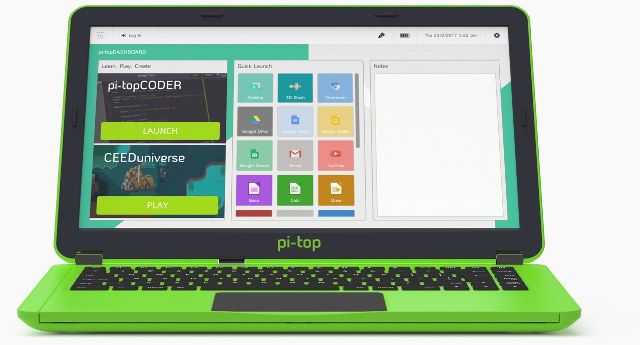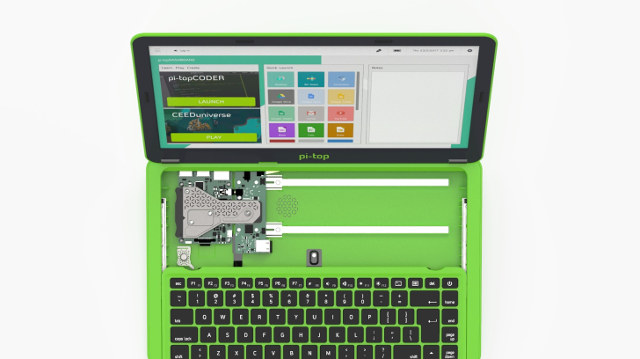Pi-Top was first launched in late 2014 via an Indiegogo crowdfunding campaign, as a modular DIY laptop powered by a Raspberry Pi board. It’s equipped with a 13.3” LCD screen with 1366×768 resolution, and uses a sliding top cover placed between the display and the keyboard where you could insert your Raspberry Pi with enough space for extra hardware.
This is a good week for DIY ARM laptops, as after the launch of Olimex TERES-I laptop yesterday, Pi-Top team has announced a new version of Pi-Top modular laptop with an larger 14″ display with 1920×1080 resolution, a sliding keyboard, and better cooling with a passive cooling unit for the Raspberry Pi 3 board.
 Pi-Top 2017 laptop specifications:
Pi-Top 2017 laptop specifications:
- Display – 14” full HD LCD screen with 1920 x 1080 resolution, 180° screen angle range
- Keyboard – 105mm sliding keyboard for internal access (US layout)
- Touchpad – 104x75mm trackpad with Gesture Control
- Officially Supported Board – Raspberry Pi 3 with Broadcom BCM2837 SoC, HDMI, Ethernet, 802.11 b/g/n WiFi, Bluetooth 4.1, Audio jack, micro SD slot, camera and display interface
- Modular Rail for pi-top accessories
- Power Supply – 18V, 2.5A charger with AU, EU, UK and US adapters
- Battery – Good for 6-8 hour battery life

The kit also includes an 8GB class 10 SD CARD with pi-topOS and an SD Card Removal Tool. pi-topOS is a firmware image specifically designed for Raspberry Pi 3 and Pi-Top with components such as pi-topCLASSROOM online classroom management software, pi-topCODER intuitive coding environment, CEEDuniverse educational space exploration game, and pi-topDASHBOARD interface.
While the company only officially supports Raspberry Pi 3, it should be possible to use other boards that are electrically and mechanically compatible to Raspberry Pi 3 board such as ODROID-C2 or ROCK64, but you may have to work on the software side. The most adventurous could also try other boards, as Bero (Linaro) used a 96Boards compliant DragonBoard 820c board in the older version of Pi-Top with some custom cabling.
The new Pi-Top can be purchased for $319.99 including shipping with a Raspberry Pi 3, or $284.99 without. A free Inventor Kit with a breadboard, and various modules and components to get started with DIY electronics.

Jean-Luc started CNX Software in 2010 as a part-time endeavor, before quitting his job as a software engineering manager, and starting to write daily news, and reviews full time later in 2011.
Support CNX Software! Donate via cryptocurrencies, become a Patron on Patreon, or purchase goods on Amazon or Aliexpress




